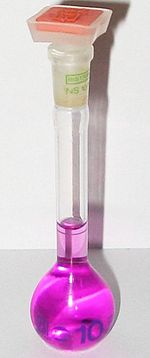Charge transfer complexes

Charge-transfer complex (abbreviated CT complexes ) are electron-donor-acceptor complexes , formed by absorption of light to change in a charge-separated state. The CT complex then returns to its basic state through radiative and non-radiative transitions. Charge transfer complexes can be purely organic complexes or transition metal complexes. Often they have an intense color.
In scientific publications, CT complexes are also equated with electron donor acceptor complexes. Strictly speaking, the definition of charge transfer complexes is narrower; electron donor acceptor complex is considered a generic term.
Charge-transfer transitions
Metal complexes
CT complexes are often complexes with a metallic center. Depending on between which parts and in which direction the partial charge transfer takes place, different transitions can be distinguished.
Transition from ligand to metal
With these compounds and complexes, it is possible that an electron of the anion or ligand is transferred to the metal atom. If the orbitals are considered, the transition takes place between the p orbitals of the ligand and the d or s orbitals of the metal. This transition is found especially in compounds with highly charged cations . Typical examples are the permanganate and chromate ions, in which an electron from the oxygen is transferred to the manganese or chromate atom . Another example are thiocyanate complexes of trivalent iron, in which an electron is transferred from the thiocyanate ion to the iron (III) ion.
Transition from metal to ligand
The transition from metal to ligand is the opposite of the transition from ligand to metal, now the metal is the donor and the ligand the acceptor. The transition now takes place from occupied d orbitals of the metal to empty π * orbitals (antibonding π orbitals) of the ligand. Suitable ligands are, for example, carbon monoxide , pyridine or pyrazole . In bipyridine complexes of divalent iron, an electron is transferred from an occupied d level of the iron (II) ion into the low-lying, unoccupied π * orbital of a bipyridine ligand.
Transition metal to metal
A charge-transfer transition from one metal to the other is possible in compounds in which a metal is present in a compound in different oxidation states. A typical example is Prussian blue , in which electrons can be shifted between bivalent and trivalent iron ions .
Transition from ligand to ligand
Electron transfers between different ligands can occur here, but these occur less frequently than in the previously described charge-transfer transitions.
Solvent complexes
If the halogens chlorine , bromine , iodine or some organic compounds are dissolved in suitable solvents , often benzene , halogenated hydrocarbons or pyridine , characteristic colors appear. These are caused by unstable Lewis acid - base complexes, in which electrons are transferred from the solvent to the dissolved molecules. Since different solvents can bind to different degrees, different solvents also produce different colors. This phenomenon is also known as solvatochromia .
colourfulness
Like the dd transitions, charge transfer transitions are usually in the visible or near ultraviolet spectral range . This means that many charge transfer complexes are colored. The eye sees the complementary color of the absorbed light. Potassium permanganate, which absorbs around 560 nm (green spectral range), appears characteristic purple.
In contrast to other transitions, the charge transfer transition is quantum mechanically permitted. A high level of absorption and therefore intense colors are therefore possible.
If charge transfer complexes are dissolved in different solvents, color shifts occur ( solvatochromism ). Different interactions play a role here, e.g. B. dipole-dipole forces , a role between the solvent molecules and the dissolved complex, which cause a shift in the absorption maximum of light to longer or shorter wavelengths.
impact
The color of many pigments is based on charge-transfer transitions. Important examples are cadmium sulfide (yellow), cinnabar (red), lead chromate (yellow) or iron oxide pigments .
literature
- AF Holleman , E. Wiberg , N. Wiberg : Textbook of Inorganic Chemistry . 102nd edition. Walter de Gruyter, Berlin 2007, ISBN 978-3-11-017770-1 , pp. 165-166.
- James E. Huheey, Ellen A. Keiter, Richard L. Keiter: Inorganische Chemie , 3rd edition, de Gruyter, Berlin 2003, pp. 531-534, ISBN 3-11-017903-2 .
- Stefan Kubik: Charge transfer complexes . In: Römpp Chemie-Lexikon , Thieme Verlag, as of November 2005.
- W. Kaim , S. Ernst, S. Kohlmann: Colored complexes: the charge transfer phenomenon in: Chemistry in our time 21 (1987) pp. 50-58; doi : 10.1002 / ciuz.19870210204 .
Individual evidence
- ↑ Hesse: Spectroscopic Methods in Organic Chemistry , p. 29.
- ↑ Jerry March: Advanced Organic Chemistry. Wiley Interscience, New York 1997, ISBN 3-528-06657-1 , p. 115 ( limited preview in Google book search).
Web links
- Ulm University, Experiment of the Month: Quinhydrone ( Memento from April 16, 2008 in the Internet Archive )
- Prof. Blume's tip of the month: experiments with catechol